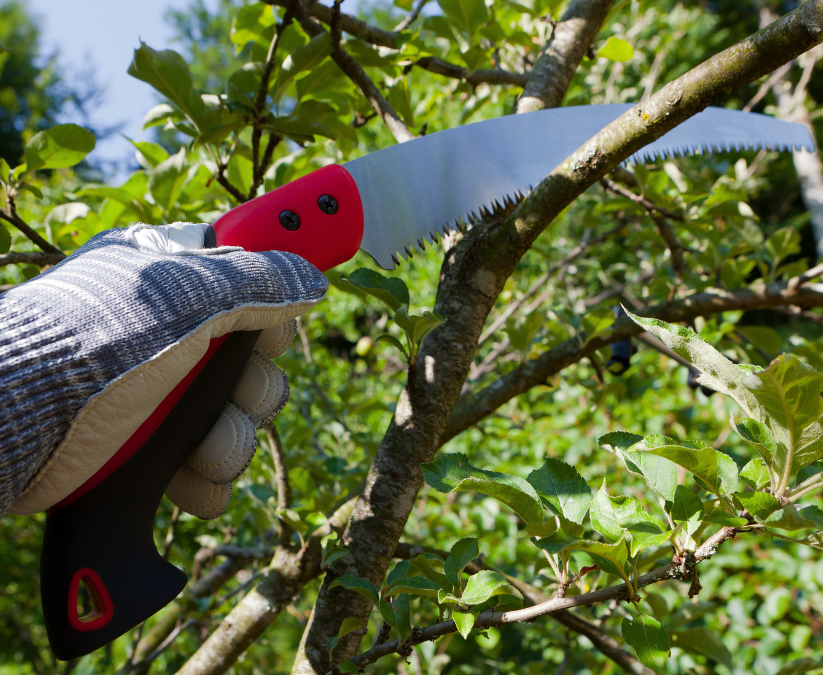Today, we’re diving into the essential topic of pruning and how to effectively manage your San Antonio, Texas garden. Pruning is not only about aesthetics; it can be crucial for the health, growth, and productivity of your plants. Whether you’re dealing with trees, shrubs, perennials, or vines, understanding when to prune can make all the difference. Let’s get started on some basic tips for pruning!
Pruning Trees
Best Time to Prune: For most trees in San Antonio, the best time to prune is during the late winter months, just before spring growth begins. This typically falls between January and early March. Pruning during this time minimizes the risk of disease and allows the tree to heal quickly in the growing season.
Exceptions:
- Spring Flowering trees: such as redbuds, Texas Mt. Laurels, magnolias, etc.. should be pruned immediately after they bloom in spring. This ensures that you don’t cut off next year’s flower buds.
- Oak trees: July through December are the ideal times to prune oaks. This greatly reduces the chances of developing and/or spreading the dreaded oak wilt virus. Always use pruning paint to treat any cuts larger than quarter-sized.
Pruning Shrubs
Best Time to Prune: The timing for pruning shrubs can vary depending on the type. For example, spring-flowering shrubs like azaleas and lilacs should be pruned right after they bloom, usually in late spring or early summer. Summer-flowering shrubs, on the other hand, are best pruned in late winter or early spring.
Exceptions: Evergreen shrubs, such as boxwood, can be lightly trimmed throughout the year but should have their major pruning done in late winter or early spring.
Pruning Perennials
Best Time to Prune: Most perennials benefit from pruning in late winter/early spring before new growth starts. This helps to remove dead or diseased parts and encourages robust growth in the new season. I prefer to hang out with a little bit of “ugly” through the winter until all danger of frost has passed. The tops of perennials, even if nipped by a freeze, still provide a layer of protection to the remaining bottom of the plant and its roots.
Exceptions:
- Many perennials that have multiple blooming seasons, like salvias, Gregg’s Bluemistflower, Plumbago, etc… can be pruned multiple times throughout the year. Pruning in late winter and again in late summer, rejuvenates these plants for fantastic spring and fall blooms.
- Ornamental grasses, should be left standing through the winter to provide habitat for beneficial insects and then cut back in early spring.
Pruning Vines
Best Time to Prune: Pruning times for vines can vary greatly. For example, spring-flowering vines like wisteria should be pruned immediately after they bloom, whereas summer-flowering vines like trumpet vine can be pruned in late winter or early spring.
Exceptions: Some vines, such as clematis, have specific pruning groups based on their bloom time and should be pruned accordingly. It’s essential to identify your vine type before pruning.
Pruning Annuals
Many people don’t realize that you can also prune many annuals. As the seasons run on, annuals can get leggy and their blooms start to look tired. Pruning annuals like petunias, vinca, angelonia, geraniums, pansies, violas etc… can push the plant into a more full, vibrant growth and allow more energy to produce another flush of flowers.
The ⅓ Rule of Pruning all Plants
The ⅓ rule is a great guideline to follow for most plants. The idea is to never remove more than one-third of the plant at a time, during its growing season. This allows the plant to recover more easily and reduces the risk of shock or damage. For example, if you are pruning a shrub, remove dead or diseased branches first, then thin out the center to allow for better air circulation, and finally, shape the plant by trimming back the outermost growth.
Exceptions:
- When pruning tropical milkweed, it is advised to cut the entire plant down to 3″ from the ground. We also recommend pruning tropical milkweed 3 times during the year. Around Nov. 1st (after the fall migration), around May 1st (after spring migration), and end of July (to get ready for the fall migration).
- Also, pruning perennials in late/winter, early spring, you can prune all the way down to where you see new growth emerging.
5 Things to Watch Out For When Pruning
- Disease and Pests: Always use clean, sharp tools to avoid spreading disease. Sterilize your tools between cuts, especially when moving from one plant to another.
- Weather Conditions: Avoid pruning during extremely hot or cold weather. Pruning during stress periods can harm the plant.
- Plant Identification: Make sure you know the specific requirements of the plant you are pruning. Some plants have unique needs and may not follow general guidelines. Please don’t overlook this step. You should learn all you can about each plant that you own.
- Structural Integrity: Focus on maintaining the natural shape and structure of the plant. Remove crossing branches and ensure good air circulation to reduce the risk of disease.
- Overwintering Beneficial Insects: Many times a chrysalis, or nests can be found nestled among dried branches in fall and winter. Be mindful of where you are making your cuts, and transport any chrysalis and nests you find to a safe place, or avoid cutting that limb.
Pruning can seem daunting at first, but with a bit of knowledge and practice, it becomes a rewarding task that greatly benefits your garden. Remember, pruning is not designed to keep a plant small or short; it is designed to help promote healthy growth and beautiful blooms. You should never be purchasing a plant that at mature growth would be way too large for your landscape. Buy according to the scaled or your landscape, and pruning will only be an occasional maintenance.
We hope to bring you more info on pruning in the future. Let us know what questions you may have.
~The Happy Gardener, Lisa Mulroy

